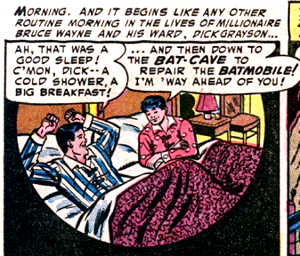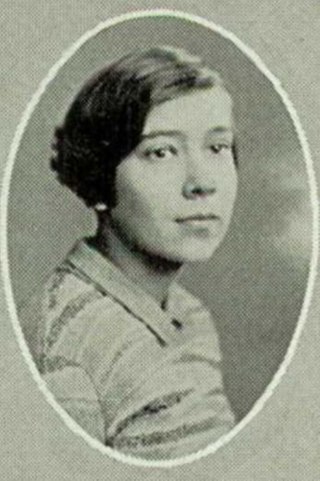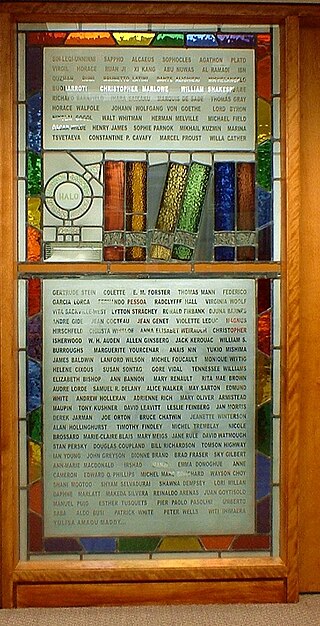Gay teen fiction is a subgenre that overlaps with LGBTQ+ literature and young adult literature. This article covers books about gay and bisexual teenage characters who are male.
The genre of young adult literature is usually considered to begin with Maureen Daly's Seventeenth Summer , which was published in 1942. Seventeenth Summer is often credited with starting young adult literature because it was one of the first adolescent problem novels. Critics trace the origin of the "new realism" or "problem novel" in teen fiction to the period from 1967 through 1969, during which S. E. Hinton's The Outsiders , Paul Zindel's The Pigman , and other pivotal titles were published. These young adult novels were characterized by candor, unidealized characters and settings, colloquial and realistic language, and plots that portrayed realistic problems faced by contemporary young adults that did not necessarily find resolution in a happy ending. Because gay young adult novels often center on problems that gay teen characters encounter because of their sexuality, these books are often classified as examples of the "problem novel" genre. [1]
In 1969, the publication of I'll Get There. It Better Be Worth the Trip by John Donovan announced the arrival of gay and lesbian literature as a new genre within young adult fiction. During and after the 2000s, and especially since the legalization of gay marriage in 2015, gay teen fiction has become a blossoming genre found in most major bookstores. [2]
In the years from 1969 through 1992, approximately sixty young adult novels with gay/lesbian characters or themes appeared in the United States. The rate of production of this body of literature has roughly doubled over the years, with approximately half (thirty-one) of the books published in the sixteen years from 1969 through 1984, and the rest (twenty-nine) published in the following eight years, from 1985 through 1992. [1] From 1998 to 2003, 42 more novels were published with LGBTQ characters. [3]
Despite the apparent wider acceptance of these novels, publishing them can be difficult. Geography Club , about a high school gay support group, was rejected seventeen times before it was published. Author Brent Hartinger said, "Editors told my agent again and again that there was no market for a book like this, and all my agent's agent-friends told her she was wasting her time on a gay teen book." [4] Publishers often seem motivated by the desire to maximize their profits, and librarians are often restricted by limited acquisitions budgets. Neither of these factors work to support, much less create, an environment in which much literature will be produced that explores homosexuality for adolescents in any meaningful way. [5]
Although larger publishing houses may reject homosexual fiction because of the smaller market, there are publishing houses available that focus on this specific genre. For almost thirty years, Alyson Books has been publishing LGBT authors, often when no other publisher would dare sign them on. Alyson Books, recently purchased by Regent Media, is the oldest LGBT book-publisher and the first to readily publish gay fiction against the marketing odds. In an interview with Gay and Lesbian Review Worldwide Don Weise talks about the important impact Alyson Books has had in gay and lesbian publishing: [6]
When I look at our backlist and see the first LGBT children's books- Heather Has Two Mommies and Daddy's Roommate , [note 1] or the first African-American gay anthologies- In the Life and Brother to Brother- or the S/M classics Coming to Power and Leatherfolk, I see a publisher with a wide vision of who we are as LGBT people. Taken together, this sampling of books recognizes that some of us are parents, some of us are people of color, and some of us enjoy sex involving BDSM. Some of us might even be all of the above. To my thinking this inclusive view is an extraordinary achievement unto itself. While I could name any number of books that I'm proud to say Alyson has published, I think the barrier-breaking nature of our past is what excites me most.
Other publishing houses have begun to show an interest in gay fiction. LPI Media, also owned by Regent Media, is now the largest gay and lesbian publisher.
The audience for such books includes both teens and adults, according to Sharyn November, a senior editor at Viking Children's Books/Puffin, who observes that "young adult used to mean books aimed at readers between the ages 16 and 21," but some of these books are now "reaching the 14 plus crowd and ideally crossing over to the adult market," although gay young adult novels are also aimed at children as young as twelve years old. [7]
Gay young adult fiction serves more than just gay teenagers, it offers gay literature to straight adolescents as well. All young adults, defined here as people who are 12 to 18 years old in transition from childhood to adulthood, are struggling with issues of responsible sexual behavior and emergent ideas of self-identity, and all young adults should have access to literature that reflects the reality of their lives, their emotions, their fears and their joys, including gay and lesbian teenagers. Furthermore, as homosexuality becomes more and more acceptable to society at large, or at least more visible, all teenagers are going to know others who are lesbian or gay, whether it is family members, teachers, friends or neighbors. [8]
Nancy St. Clair describes the benefits of including homosexual fiction in adolescent classrooms for both the homosexual and straight students: "For the straight students, the course offers the opportunity to study a culture they are curious about, but which the homophobia, so prevalent in student life, prevents them from freely exploring. My course, then, becomes a mandate to explore that which is taboo for many of them. For lesbian students the unit offers both a validation of their experience and an arena where their voices can be heard." [5]
Yet, given the status of young adults as minors, many topics of interest to them, such as homosexuality, are controversial. [8] As Nancy St. Clair describes in her article: "Adults have been eager to have the genre moralize, to perform a social service, while the adolescent has been eager for an understanding of society and his/her emerging, if continuing sexuality. Still, the decade beginning with the mid-1970s and running to the mid-1980s saw the publication of a second category of novels, ones in which the representation of adolescent homosexuality became increasingly complex and decreasingly moralistic." [5]
Despite the controversy over gay fiction for young adults there is still a need for books dealing with homosexuality for adolescents. Nancy St. Clair argues, "If we as teachers truly believe that literature helps students understand themselves and the issues they face, then we have an obligation to provide our gay students with the same resources as we do other minority students." [5] Public libraries, committed to providing materials to young adults to meet their educational, recreational and social information needs, should collect materials that address these needs. [8]
USA Today reported that, "No longer do gay young adult novels simply ask, 'Am I gay?' Now they explore how to navigate in the journey for love." [7]
Contemporary gay young adult novels typically involve a teenage protagonist, teen issues, and the first-person point of view. These novels have come to deal with a variety of gay-related issues and themes.
The annual Rainbow List is created by the Rainbow Round Table (RRT) of the American Library Association (ALA). This best-of-the-year list is selected by librarians who are members for the RRT.
Another indication, some say, that gay young adult novels have gained wider acceptance in recent years is the fact that, since 1999, four gay-themed books, or books with gay secondary characters, have won the Young Adult Library Services Association's Michael L. Printz Award. [3] This award, named for a Topeka, Kansas school librarian and sponsored by Booklist, a publication of the ALA, is given in recognition of a work that demonstrates literary excellence in young adult literature.
The Lambda Literary Award, which is awarded in recognition of works that celebrate or explore LGBT themes, also recognizes children's/young adult literature.
Other examples of recognition include the ALA's "Best Books for Young Adults" award, whose winners have included Rainbow Boys by Alex Sanchez and Boy Meets Boy by David Levithan.

The Stonewall Book Award is a set of three literary awards that annually recognize "exceptional merit relating to the gay/lesbian/bisexual/transgender experience" in English-language books published in the U.S. They are sponsored by the Rainbow Round Table (RRT) of the American Library Association (ALA) and have been part of the American Library Association awards program, now termed ALA Book, Print & Media Awards, since 1986 as the single Gay Book Award.

LGBT themes in speculative fiction include lesbian, gay, bisexual, or transgender (LGBTQ) themes in science fiction, fantasy, horror fiction and related genres.[a] Such elements may include an LGBT character as the protagonist or a major character, or explorations of sexuality or gender that deviate from the heteronormative.
Young adult literature (YA) is typically written for readers aged 12 to 18 and includes most of the themes found in adult fiction, such as friendship, substance abuse, alcoholism, and sexuality. It is characterized by simpler world building than adult literature as it seeks to highlight the experiences of adolescents in a variety of ways. There are various genres within young adult literature.

Heather Has Two Mommies is a children's book written by Lesléa Newman with illustrations by Diana Souza. First published in 1989, it was one of the first pieces of LGBTQ+ children's literature to garner broad attention.
Nancy Garden was an American writer of fiction for children and young adults, best known for the lesbian novel Annie on My Mind. She received the 2003 Margaret Edwards Award from the American Library Association recognizing her lifetime contribution in writing for teens, citing Annie alone.

Lesbian pulp fiction is a genre of lesbian literature that refers to any mid-20th century paperback novel or pulp magazine with overtly lesbian themes and content. Lesbian pulp fiction was published in the 1950s and 1960s by many of the same paperback publishing houses as other genres of fiction, including westerns, romances, and detective fiction. Because very little other literature was available for and about lesbians at this time, quite often these books were the only reference the public had for modeling what lesbians were. English professor Stephanie Foote commented on the importance of lesbian pulp novels to the lesbian identity prior to the rise of organized feminism: "Pulps have been understood as signs of a secret history of readers, and they have been valued because they have been read. The more they are read, the more they are valued, and the more they are read, the closer the relationship between the very act of circulation and reading and the construction of a lesbian community becomes…. Characters use the reading of novels as a way to understand that they are not alone." Joan Nestle refers to lesbian pulp fiction as “survival literature.” Lesbian pulp fiction provided representation for lesbian identities, brought a surge of awareness to lesbians, and created space for lesbian organizing leading up to Stonewall.

Gay literature is a collective term for literature produced by or for the gay community which involves characters, plot lines, and/or themes portraying male homosexual behavior.
This article deals with writing that deals with LGBT themes in a Singapore context. It covers literary works of fiction, such as novels, short stories, plays and poems. It also includes non-fiction works, both scholarly and targeted at the general reader, such as dissertations, journal or magazine articles, books and even web-based content. Although Singapore lacks a dedicated gay book publisher or gay bookshop, it does have at least one dedicated gay library, Pelangi Pride Centre, which is open weekly to the public. Many of the works cited here may be found both in Pelangi Pride Centre, as well as the National Library or other academic libraries in Singapore, as well as in some commercial bookshops under 'gender studies' sections.

LGBTQ themes in horror fiction refers to sexuality in horror fiction that can often focus on LGBTQ+ characters and themes within various forms of media. It may deal with characters who are coded as or who are openly LGBTQ+, or it may deal with themes or plots that are specific to gender and sexual minorities.

In comics, LGBT themes are a relatively new concept, as lesbian, gay, bisexual, and transgender (LGBTQ) themes and characters were historically omitted from the content of comic books and their comic strip predecessors due to anti-gay censorship. LGBT existence was included only via innuendo, subtext and inference. However the practice of hiding LGBT characters in the early part of the twentieth century evolved into open inclusion in the late twentieth and early twenty-first centuries, and comics explored the challenges of coming-out, societal discrimination, and personal and romantic relationships between gay characters.

Valerie Taylor was an American author of books published in the lesbian pulp fiction genre, as well as poetry and novels after the "golden age" of lesbian pulp fiction. She also published as Nacella Young, Francine Davenport, and Velma Tate. Her publishers included Naiad Press, Banned Books, Universal, Gold Medal Books, Womanpress, Ace and Midwood-Tower.

Marijane Agnes Meaker was an American writer who, along with Tereska Torres, was credited with launching the lesbian pulp fiction genre, the only accessible novels on that theme in the 1950s.

Lesbian literature is a subgenre of literature addressing lesbian themes. It includes poetry, plays, fiction addressing lesbian characters, and non-fiction about lesbian-interest topics. A similar term is sapphic literature, encompassing works that feature love between women that are not necessarily lesbian.
Young adult romance literature is a genre of books written for teenagers. As defined by Romance Writers of America, a romance novel consists of a central love story and an emotionally satisfying ending. Early young adult romances feature a teenage protagonist, who is typically female, white, and middle-class, while books in the twenty-first century include a wider variety of protagonists.

LGBTQ sex education is a sex education program within a school, university, or community center that addresses the sexual health needs of LGBTQ people.

In the post-Stonewall era, the role of libraries in providing information and services to LGBTQ individuals has been a topic of discussion among library professionals. Libraries can often play an important role for LGBTQ individuals looking to find information about coming out, health, and family topics, as well as leisure reading. In the past 50 years, advocate organizations for LGBTQ content in libraries have emerged, and numerous theorists have discussed various aspects of LGBTQ library service including privacy concerns, programming, collection development considerations and librarian/staff education needs, as well as special services for juvenile and teen patrons.

The following outline offers an overview and guide to LGBTQ topics:
LGBT romance is a genre within gay literature and romance fiction focused on same-sex characters who fall in love and have a homosexual or homoromantic relationship. The genre has met with increasing acceptance and sales from the 1980s onward. Bussel, in Publishers Weekly, notes that as of 2020, presses that specialize in LGBTQ romance, mainstream publishers, and booksellers are expanding their offerings and inviting a more diverse authorship.
Bisexual literature is a subgenre of LGBTQ literature that includes literary works and authors that address the topic of bisexuality or biromanticism. This includes characters, plot lines, and/or themes portraying bisexual behavior in both men and women.
LGBT literature in Iceland consists of literary works written by Icelandic authors that contain plots, themes, or characters which are part of or related to LGBT people. The first Icelandic literary references to homosexuality are found in the Sagas of Icelanders, particularly in Njáls saga. Its protagonist has a friendship which some researchers have described as homoerotic.